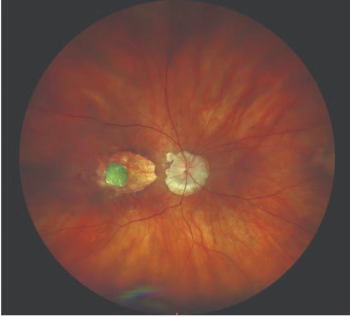
Investigators make case for postop faceup positioning for RDDs with inferior retinal breaks
In one of the first studies of the faceup position, researchers found its use after vitrectomy of rhegmatogenous retinal detachment may be beneficial in some patients.
Postoperative facedown positioning has been favored for patients who have undergone vitrectomy.
However, as the authors of a recent report in the International Journal of Retina and Vitreous1 pointed out, the value of facedown positioning is “limited” in that the main function of the intraocular tamponade is occlusion of the retinal breaks until retinopexy is performed and firm adhesion is established, and the remaining retina will flatten even in the presence of residual subretinal fluid.
In addition, patients’ lack of compliance with the uncomfortable facedown position is a major drawback, making an alternative especially welcome.
Amr Mohammed Elsayed Abdelkader, MD, and Hossam Youssef Abouelkheir, MD, said they believe the importance lies in tamponading or plugging the breaks rather than pushing the retina backwards towards the posterior pole. This is where the faceup position comes in for patients who have no posterior retinal breaks.
Dr. Abdelkader is a lecturer in the Department of Ophthalmology at Mansoura Ophthalmic Center at Mansoura University, Mansoura, Egypt. Dr. Abouelkheir is an assistant professor of ophthalmology at Mansoura Ophthalmic Center.
Study
The authors conducted a study from August 2016 to October 2019 that included 32 eyes of 32 patients (mean age: 38.72 years; range: 21 to 63 years) with rhegmatogenous retinal detachments (RRDs) resulting from multiple breaks in the peripheral and inferior retina with the goal of evaluating the effectiveness of faceup positioning after 23-gauge pars plana vitrectomy (PPV) and silicone oil injection.
The patients were instructed to maintain the faceup position for from 10 to 14 days postoperatively. Three to 6 months later, the silicone oil was removed from the eyes in which the retinas had reattached.
Related:
The patients had been instructed to strictly maintain the position during the first 6 to 8 hours postoperatively and then as long as possible throughout the following days.
The patients were examined on the first postoperative day and then weekly for 1 month and monthly until the silicone oil was removed. The patients then were followed for an additional 6 months.
Of the 32 patients, 22 eyes were phakic and 10 eyes were pseudophakic with a posterior chamber intraocular lens (IOL). The crystalline lens was clear in 14 eyes; 8 eyes were cataractous in varying degrees. Combined PPV and phacoemulsification with implantation of a posterior chamber IOL were performed in 4 cases.
Results
Drs. Abdelkader and Abouelkheir reported that the maculas were flat in two cases. Peripheral iatrogenic retinal holes occurred intraoperatively in 4 cases and peripheral retinotomies were performed in 3 cases. The final numbers of retinal breaks that included iatrogenic holes and retinotomies were 3 in 14 eyes, 4 in 12 eyes, 5 in 4 eyes and 6 in 2 eyes.
The investigators reported that the retinas reattached in 30 eyes and remained attached following removal of the silicone oil. In 1 eye, lower re-detachment under silicone oil occurred.
The patient’s relatives reported that the patient was reluctant to maintain the postoperative positioning.
Related:
The patient underwent a second surgery and retinectomy to the inferior peripheral retina was performed. This was followed by a new laser application and injection of heavy silicone oil, which was removed about 2 months later at which time the retina remained attached.
In a second case, the rhegmatogenous retinal detachment recurred after the silicone oil was removed 6 months after the primary surgery. The detachment resulted from a hole that had been overlooked just posterior to the site at which the laser had been applied.
During the second surgery, the eye was left filled with air and the retina flattened successfully.
Among all patients, the best-corrected visual acuity improvedsignificantly (P < 0.0001) from the preoperative mean logarithm of the minimum angle of resolution (logMAR) of 1.65 ± 0.71 to the postoperative mean of 0.85 ± 0.39).
The mean preoperative IOP was 10.38 ± 1.8 mmHg) and increased to 15.41 ± 3.23 mmHg) 1 month after vitrectomy. As a result, 3 cases that had undergone phacoemulsification and PPV required use of antiglaucoma medications.
The elevated IOP resulted from either residual viscoelastic materials or inflammatory reaction and gradually decreased in 2 cases and the antiglaucoma medications were discontinued. The third case needed continuous use of topical anti-glaucoma even after the silicone oil was removed.
Related:
“The [faceup position] could be a universal position for all peripheral breaks. In assuming this position, 360° circumference of the retinal periphery is adequately supported at the same time,” investigators concluded. “This will be ideal for cases with multiple, inferior and undetected breaks. Since both [the faceup and facedown positions] are effective, we may give our patients the option to choose between the two positions giving a chance for better compliance. The possibility of using alternating [the faceup and facedown positions] postoperatively may be another option but needs a separate evaluation in another study.
---
Reference
1. Abdelkader, AM, Abouelkheir, HY. Supine positioning after vitrectomy for rhegmatogenous retinal detachments with inferior retinal breaks. Int J Retin Vitr 2020;6:41 (2020).
Newsletter
Keep your retina practice on the forefront—subscribe for expert analysis and emerging trends in retinal disease management.














































